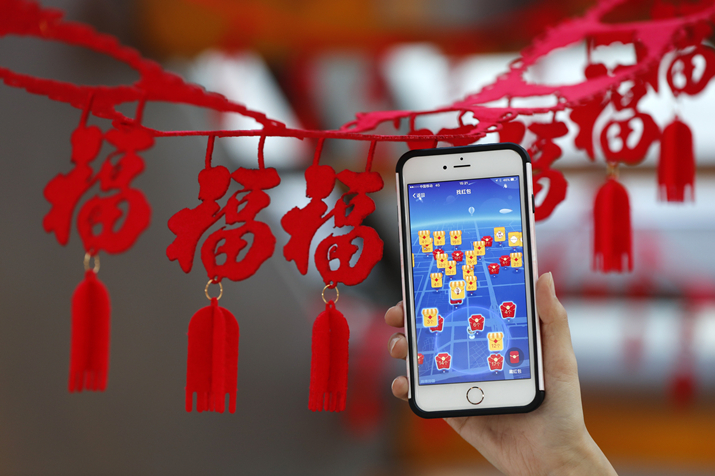|
||||||||||
| Home Nation World Business Opinion Lifestyle ChinAfrica Multimedia Columnists Documents Special Reports |
|
||||||||||
| Home Nation World Business Opinion Lifestyle ChinAfrica Multimedia Columnists Documents Special Reports |
| ChinAfrica |
| Buying into Change |
| Chinese spread their wings and open their wallets during the Spring Festival |
| By Xia Yuanyuan | VOL.10 February 2018 ·2018-02-09 |

For Chinese people, the Spring Festival is the heart and soul of the nation's many annual celebrations. The eagerly anticipated week-long holiday that incorporates Chinese New Year is a joyful time of family reunion, good food and frenetic shopping. People are attracted to numerous "sales" in both brick-and-mortar and online stores.
As many urban dwellers make the often long trek to their hometowns across the country, or embark on travel abroad, both domestic and overseas consumption has soared. According to data from the Ministry of Commerce of China, during the 2017 Spring Festival, sales in the catering and retail sectors reached 840 billion yuan ($129 billion), up 11.4 percent year on year. In addition, changes have appeared in the buying patterns of people during the festival.
High-quality products have become the items of choice for many consumers and outbound traveling is now popular for Chinese families during this holiday. The Internet also plays a bigger role in festival culture with increasing popularity of online shopping.
High quality in demand
Along with the increase of Chinese incomes, the expansion of middle-class families and the rising awareness in people's health, top-of-the-range products are the most sought-after, such as upmarket wine, jewelry and clothes.
"My food consumption pattern has changed from having enough to eat to a preference for healthy meals," 64-year-old Huang Chunqiao, a Beijing resident told ChinAfrica.
"Quality comes first when I buy," said Huang. "On selecting products and gifts for the Spring Festival, instead of price, brand and reputation are aspects I would consider," Huang added. However, in the Chinese market, the range in product quality is vast. In recent years, China has stressed the need for quality, instead of quantity in economic growth, and has more cognizance of the need to shut down factories that pollute the environment, in favor of satisfying people's ever-growing needs for more quality products and improved lifestyle.
At the 19th National Congress of the Communist Party of China (CPC) in late 2017, a consensus was reached that the economy continues to transit from a phase of rapid growth to a stage of high-quality development. "For the economy, the most prominent problem now is growth quality, and we need to address unbalanced and inadequate development through changes in quality, efficiency and growth drivers," said Yang Weimin, Deputy Head of the Office of the CPC Central Leading Group for Financial and Economic Affairs. This trend has, to a large extent, been driven by consumer demands.
From offline to online

E-hongbao - red gift envelopes sent via social media apps are now in fashion
E-commerce has boosted Spring Festival sales dramatically. Now, instead of fighting crowds and struggling under the weight of shopping bags, Chinese consumers prefer to sit in the comfort of their homes and use online shopping apps.
"I can buy anything I want online instead of shuttling back and forth between different shops. And before the Spring Festival, many e-commerce companies launched online shopping discount to coincide with the holiday. Prices are much lower than those in physical stores," said Beijing resident Li Xiang.
According to statistics jointly published by Alibaba and CBNData, during the 2016 Spring Festival shopping spree, 280 million items were moved across the country in a non-stop delivery operation, not matched anywhere else on earth. There were more than 300,000 express delivery couriers working during the Spring Festival holidays in 2017, according to Alibaba's logistics arm, Cainiao Network. Compared with the 120,000 in 2016, it is evident just how much consumer spending had increased and the kind of delivery capacity been involved.
Online retailers such as JD.com and Suning.com have also played a key role in this growth, as they stayed open during the holidays and offered sales promotions to attract consumers. Another large source of consumption during the Spring Festival for Chinese is hongbao (red envelopes) - a tradition where older relatives give red envelopes containing lucky money to children. Now, virtual red envelopes are also trendy.
WeChat, Huajiao Live, Baidu Wallet and Alipay have popularized this concept, in which one user can send a virtual red envelope directly to someone else. The red envelope is linked to money that is deposited to users' accounts to be used online or in brick-and-mortar stores.
Crossing borders
In recent years, people have become more eager to pursue alternative ways to celebrate the Spring Festival. Family gatherings are no longer restricted to hometowns, but now also to tour abroad.
"Being the longest holiday [in the annual calendar], instead of attending parties, dinners or shopping, I think it's more meaningful to travel with my family and relax," said Wang Qian, a Shanghai resident.
According to statistics from online travel services provider Ctrip, during the Spring Festival in 2017, Chinese tourists from 242 domestic cities traveled to 1,254 cities in 85 countries and regions, and in total, more than 6 million overseas trips were taken with 100 billion yuan ($14.5 billion) spent.
Similarly, these tourists have higher demands on travel services now. Ctrip said 60 percent of the hotel reservations by Chinese in overseas trips were in four- and five-star hotels. The preference for better star-rated hotels means Chinese are willing to spend more to ensure enjoyable travel.
Zhang Yang, a resident in Beijing, will take her family to Singapore this holiday. "We want to go somewhere warm to escape the cold weather in north China," she said. Other popular destinations include New Zealand, Fiji and Tahiti. Also surprisingly, despite the high expense, celebrating the Spring Festival at the South Pole is a new popular choice among Chinese. Although one trip costs more than 200,000 yuan ($29,800) per person, an increasing number of Chinese people with deep pockets and a sense of adventure are making this voyage to the Antarctic.
| About Us | Contact Us | Advertise with Us | Subscribe |
| Copyright Beijing Review All rights reserved 京ICP备08005356号-5 京公网安备110102005860号 |